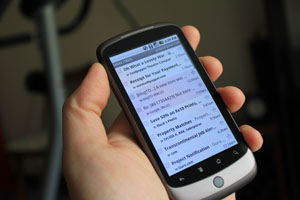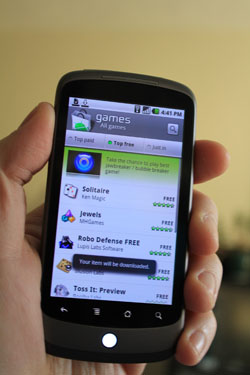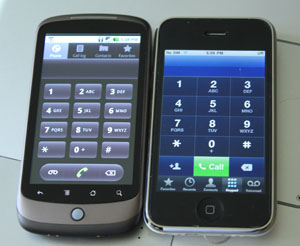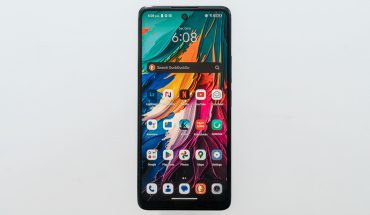
By Gadjo Cardenas Sevilla
Designed by HTC under Google’s strict supervision, the Nexus One represents the cutting edge of hardware and software for the Android OS that’s widely available to all. Released a week ago for AT&T and Rogers subscribers, the Nexus One can run on any network. It also ushers in a new distribution model for smartphone where Google sells unlocked phones directly form their website and supports the OS independently from the carriers.
For Canadians, the Nexus One costs US $556.16 plus Canadian $77.00 for import fees. The unit arrives two to three days via DHL.
Turns out the Rogers compatible Nexus One will work perfectly with Bell and Telus provided you enter those carrier’s APN (Access Point Name) information. We popped in our Telus SIM and were up and running.

The Nexus One’s 3.7 AMOLED screen is outstanding. It is so bright and saturated that even at the lowest brightness settings it is extremely readable and reasonably bright. Black is really black, not dark grey but some of the colours may seem a bit too saturated (reds tend to approach dark pink). The problem is, once you use it outdoors, the screen is so reflective, it is barely readable.
The Nexus One is thinner and lighter than the iPhone 3GS; its body is made from a mix of aluminum and rubberized plastic. It feels soft and velvety and while we’re happy it isn’t another one of those glossy black smartphones we’ve seen so much of, we get the feeling that the N1 isn’t as sturdy as the iPhone 3GS.
It feels like it could easily slip though your fingers and hit the floor so some sort of bulk-adding protection is required. The screen seems pretty resistant to smudges and fingerprints and the tactile vibration, which vibes when you type, also helps your accuracy when typing or moving information around.
The Nexus One, much like the Palm Pre, is shaped and feels like a polished stone. It is one of the nicest smartphones to hold in one’s hand, a true tactile treat. No sharp edges, no unnecessary protrusions (save for the backlit LED trackball, the volume rocker and the 5 Megapixel camera). It isn’t as slick and austere as the iPhone 3GS, but it is very close. The small trackball seems almost incidental since the touchscreen does it all but it does glow different colours as an added alert to emails, text messages or Twitter updates.

The software keyboard is large and manageable. It may not be as intuitive as the iPhone’s but it looks like it can add commonly used words to its dictionary. Those who aren’t keen on typing on glass can use Google’s Voice Search as well as Voice Input feature particular to Android 2.1. Once you get over hearing yourself talking to the phone, you realize this technology works quite well, especially with the navigation app.
Android OS 2.1 is the latest, greatest Android OS and it is optimized to run on the Nexus One’s speedy 1GHz Snapdragon processor. Scrolling and screen refreshes when tilting and changing orientation is very fast as it the loading of applications. Using the default Google Search bar on the Nexus One yields results in around 3 seconds on WiFI and around 5 using Telus 3G.
The speed of the Nexus One is best tested when you fire up an app like Google Maps or Google Earth which are data and graphics intensive apps that are very similar to their desktop counterparts. Google Earth uses the GPS, Wi-Fi and 3G radios plus the compass and accelerometers and the N1 crunched it without any discernible lag.
Same with video which the Nexus One can manage at 720p HD, which is impressive. Video playback on this device is stunning and audio is quite passable.
Call quality is excellent and clear thanks to dual microphones that manage to isolate external noise while enhancing the voice aspect. This also helps with all the Google voice applications.
Coming from an iPhone, you do miss the large variety of apps from the iTunes App Store, the ability to buy music and video as well as the thousands of cases, accessories and solutions that are iPhone specific. Google seems to have big plans for the Nexus One and by making it available to all major carriers.
While there are a growing number of Android Apps there aren’t enough right now to challenge the iPhone, especially in the games department where the iPhone has gained a substantial lead.
Battery life is surprisingly good and better than the Motorola Milestone. On a full charge, we were able to get through two days of use with a lot of web surfing, Twitter, Facebook and email use. We had the AMOLED screen turned all the way down and was still bright and clear.

The 5 Megapixel camera is one of the better ones we’ve tried. It can handle stills and video plus has settings for white balance, flash mode, colour effect and focus mode. It takes decent photos users can use the Gallery application to post images to online photos services or share via MMS or email.
The Google Nexus One is a fantastic smartphone, it is more like a handheld computer and really the best example of what a Google phone could be, provided you don’t want a slide-out keyboard, the Motorola Milestone is still the best phone for that.
With its off-the-wall specs and opulent screen plus its refined handling of the Android OS, the Google Nexus One is powerful, versatile and innovative player in the smartphone market.
Rating 4.5 out of 5



Nice review Gadjo, I’m glad we have a good N1 review now.
It’s going to be interesting to see where this goes, now that there’s a full on war between Google and Apple. With these powerful politics, the user experience with these devices will depend as much on the strategic positioning of these giants as it does on the actual hardware.
Apple has become almost toxic with its anti-competitive and stringently proprietary politics. They take so much power out of the hands of the developers because, like a crack dealer, Apple needs people to become dependent on their products, and need to hold power to do so. Android is open-source. The developers have so much power because of this. So while Apple’s head start may have them on the stronger side of the market right now, I think you NEED to point out that the rate of improvement of the user experience with the N1 far surpasses that of the iPhone. This means more and better apps in the long run! In fact, I would argue that Apple’s recent censoring moves are taking the iPhone two steps back.
Since the N1 comes from Google itself, I hope we can expect that Android will be readily updateable. This is in stark contrast to many carriers who refuse to update their phones because they want you to upgrade and sign a new contract.
For anyone who would like some insight into these politics, Tim Bray—who recently went to work for Google—has a very interesting blog post that summarize a perspective on the situation which I share. He also makes a lot of very good points. According to him, the iPhone sells 90K units per day, and the N1 does 60K. That’s saying something. Between the N1 and Windows Phone 7 coming out, I think Apple is going to fade into the background again, the way it did with the personal computer. Will they rise again after? That’s anyone’s guess.